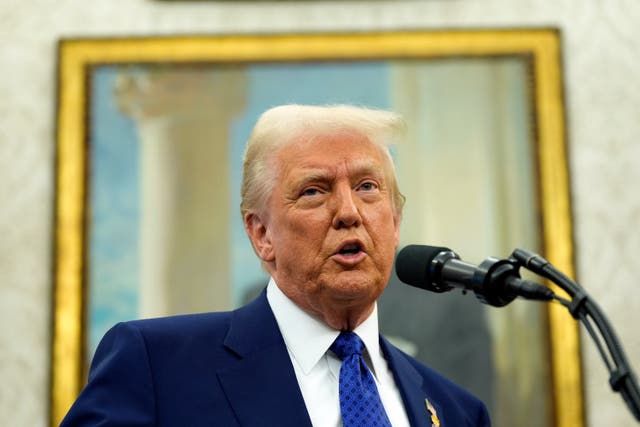Trump signs plan to increase tariffs on trading partners
The new taxes would likely be paid by American consumers and businesses either directly or in the form of higher prices.

President Donald Trump has rolled out his plan to increase US tariffs to match the tax rates that other countries charge on imports, possibly triggering a broader economic confrontation with allies and rivals alike.
“I’ve decided for purposes of fairness that I will charge a reciprocal tariff,” Mr Trump said in the Oval Office at the proclamation signing. “It’s fair to all. No other country can complain.”
His Republican administration has insisted that its new tariffs would level the playing field between US manufacturers and foreign competitors, though these new taxes would likely be paid by American consumers and businesses either directly or in the form of higher prices.
The politics of tariffs could easily backfire on Mr Trump if his agenda pushes up inflation and grinds down growth, making this a high stakes wager for the president.

The tariff increases would be customised for each country with the partial goal of starting trade new negotiations.
But other nations might also feel the need to respond with their own tariff increases on American goods.
As a result, Mr Trump may need to find ways of assuring consumers and businesses that growth will counteract any uncertainty from the possible fallout from his tariffs.
His proclamation identifies value added taxes — which are similar to sales taxes and common in the European Union — as a trade barrier to be included in any reciprocal tariff calculations, according to a senior White House official.
Other nation’s tariff rates, subsidies to industries, regulations and possible undervaluing of currencies would be among the factors the Trump administration would use to assess tariffs.
The official said that the expected tariff revenues would help to balance the expected 1.9 trillion dollar budget deficit. The official also said the reviews needed for the tariffs could be completed within a matter of weeks or a few months.
The possible tax increases on imports and exports could be large compared to the comparatively modest tariffs that Mr Trump imposed during his first term.
Trade in goods between Europe and the United States nearly totalled 1.3 trillion dollars last year, with the United States exporting 267 billion less than it imports, according to the Census Bureau.
The president has openly antagonised multiple US trading partners over the past several weeks, levying tariff threats and inviting them to retaliate with import taxes of their own that could send the economy hurtling into a trade war.
Mr Trump has put an additional 10% tariff on Chinese imports due that country’s role in the production of the opioid fentanyl.
He also has readied tariffs on Canada and Mexico, America’s two largest trading partners, that could take effect in March after being suspended for 30 days.
On top of that, on Monday, he removed the exemptions from his 2018 steel and aluminium tariffs. And he has mused about new tariffs on computer chips and pharmaceutical drugs.
The EU, Canada and Mexico have counter measures ready to inflict economic pain on the United States in response to Mr Trump’s actions, while China has already taken retaliatory steps with its own tariffs on US energy, agricultural machinery and large-engine autos as well as an investigation of Google.
Analysts at the bank Wells Fargo said in a Thursday report that the tariffs would likely hurt growth this year, just as the extended tax cuts could help growth recover in 2026.
“Tariffs impart a modest stagflationary shock to an economy,” the report said. “The US economy entered 2025 with a fair amount of momentum, but we look for real GDP growth to downshift a bit over the next few quarters as the price-boosting effects of tariffs erode growth in real income, thereby weighing on growth in real consumer spending.”





